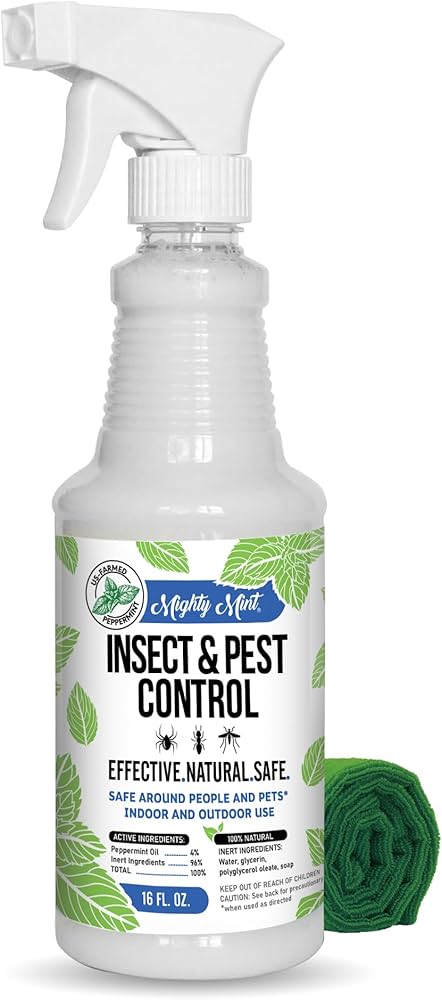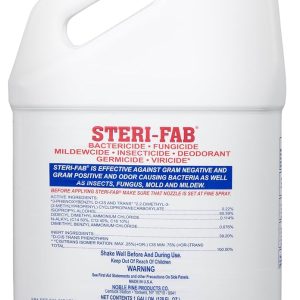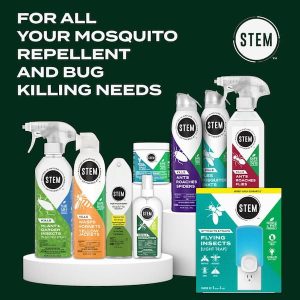
When it comes to keeping unwanted pests at bay, many homeowners are turning away from harsh chemical sprays and embracing natural alternatives. Among these eco-friendly solutions, peppermint spray for bugs has emerged as one of the most effective and popular choices. This natural pest deterrent not only keeps your home free from insects but also leaves behind a refreshing minty scent that humans love.
The power of peppermint oil as a bug repellent isn’t just folklore passed down through generations. Scientific research backs up its effectiveness, making it a legitimate alternative to conventional pest control methods. Unlike synthetic pesticides that can pose health risks to your family and pets, peppermint-based solutions offer a safer approach to pest management without compromising on results.
How Peppermint Spray for Bugs Actually Works
Understanding the science behind peppermint spray for bugs helps explain why this natural solution is so effective against various pests. The secret lies in the plant’s powerful chemical compounds, particularly menthol and menthone, which create an environment that insects find extremely uncomfortable and disorienting.
Researchers stated its high levels of menthol and menthone were essentially responsible for its effectiveness. So, the refreshing minty smell creates a confusing environment for bugs, making peppermint oil a practical and eco-friendly insect repellent to use around the house. These compounds work by overwhelming the insects’ sensory systems, making it difficult for them to navigate and locate food sources.
The effectiveness of peppermint oil stems from its ability to disrupt the insects’ pheromone trails and communication systems. When bugs encounter the strong menthol scent, their natural behavior patterns become confused, leading them to avoid the treated areas entirely. This makes peppermint bug spray particularly effective as a preventive measure rather than a direct killing agent.
Key Active Compounds in Peppermint Oil:
- Menthol (35-45%): Primary repellent compound
- Menthone (15-25%): Secondary deterrent
- Menthyl acetate (5-10%): Enhances scent intensity
- Limonene (2-5%): Additional insect deterrent
Which Bugs Does Peppermint Spray Repel Most Effectively?
Not all insects respond equally to peppermint spray for bugs, and understanding which pests are most susceptible can help you use this natural solution more strategically. Generally speaking, peppermint oil as pest repellent is most effective when used against soft bodied insects.
Most Effective Against:
- Ants: Disrupts their scent trails and communication
- Spiders: Overwhelms their sensitive leg receptors
- Mosquitoes: Creates an uncomfortable sensory barrier
- Gnats and fruit flies: Confuses their navigation systems
- Aphids: Particularly vulnerable to menthol compounds
- Cockroaches: Deters them from entering treated areas
Moderately Effective Against:
- Wasps and hornets: May deter but won’t eliminate established nests
- Beetles: Some species more responsive than others
- Fleas: Can help as part of integrated pest management
- Ticks: Limited effectiveness compared to other essential oils
Research has shown varying degrees of success depending on the insect species. One study found that peppermint oil repelled 84-100% of mosquitoes, depending on the species. However, it’s important to note that while peppermint spray effectively deters many bugs, “While peppermint oil can deter pests, it doesn’t kill them and can hardly be effective as a single method.”
Scientific Evidence: What Research Says About Peppermint Bug Spray
The effectiveness of peppermint spray for bugs isn’t just anecdotal evidence from satisfied homeowners. Multiple scientific studies have investigated the repellent properties of peppermint oil, providing concrete data on its pest control capabilities.
Mosquito Repellency Studies
A 2011 study published in The Asian Pacific Journal of Tropical Biomedicine, found that peppermint oil offered up to 2.5 hours of protection against yellow fever mosquito bites. This research demonstrated that peppermint oil could provide meaningful protection periods, though shorter than synthetic repellents.
The undiluted essential oil was shown to be an effective repellent for 45 minutes. While this may seem brief, it’s important to remember that natural repellents typically require more frequent application than their chemical counterparts.
Comprehensive Essential Oil Testing
Recent research has taken a more systematic approach to testing essential oils. New Mexico State University graduate student Hailey Luker’s research demonstrating the effectiveness of various essential oils as mosquito repellents was published recently in the journal “Nature.” This comprehensive study evaluated multiple essential oils, providing valuable comparative data.
The essential oil was proved to be 11.8 % more effective when the exposure of the larvae to essential oil continued for 48 h, exhibiting an LC50 value of 98.66 ppm. This research specifically focused on peppermint oil’s larvicidal properties, showing its potential for controlling mosquito breeding sites.
Concentration and Effectiveness
Studies have revealed that concentration plays a crucial role in effectiveness. Only high concentrations of peppermint oil repelled Ae. aegypti. None of the oils tested prevented mosquito bite when used at the 5 or 10% concentration. This finding emphasizes the importance of proper dilution ratios when creating homemade peppermint bug spray.
DIY Peppermint Spray for Bugs: Step-by-Step Recipe
Creating your own peppermint spray for bugs is both cost-effective and allows you to control the ingredients. Here’s a comprehensive guide to making an effective homemade solution:
Basic Peppermint Bug Spray Recipe
Ingredients:
- 20-30 drops of pure peppermint essential oil
- 2 cups of water (distilled or filtered preferred)
- 1 tablespoon of dish soap (acts as emulsifier)
- 1 spray bottle (16-20 oz capacity)
Instructions:
- Fill the spray bottle with water, leaving room for other ingredients
- Add dish soap and swirl gently to mix
- Add peppermint oil drop by drop while swirling
- Shake vigorously for 30 seconds to ensure proper mixing
- Label the bottle with contents and date
- Test spray on a small, inconspicuous area first
Enhanced Formula for Maximum Effectiveness
For areas with heavy pest pressure, consider this stronger formulation:
Ingredients:
- 40 drops peppermint essential oil
- 10 drops tea tree oil (additional pest deterrent)
- 2 cups water
- 2 tablespoons white vinegar (helps preserve and enhance effectiveness)
- 1 tablespoon liquid castile soap
Pro Tips for Maximum Effectiveness:
- Use high-quality essential oil: 100% pure peppermint oil works best
- Shake before each use: Oil and water separate naturally
- Store in cool, dark place: Preserves oil potency
- Replace every 1-2 weeks: Fresh batches maintain effectiveness
Application Techniques and Best Practices
Knowing how to properly apply peppermint spray for bugs can significantly impact its effectiveness. The application method and timing can make the difference between success and disappointment with natural pest control.
Indoor Application Guidelines
Target Areas for Indoor Use:
- Window sills and door frames
- Kitchen counters and cabinets
- Basement entry points
- Areas where you’ve seen pest activity
- Pet food storage areas
- Garbage can surroundings
Application Frequency: Spraying peppermint oil for bug control isn’t an exact science, but a good starting point is every 3-7 days. This frequency allows you to maintain a strong enough scent barrier to deter most common pests.
Indoor Application Steps:
- Clean surfaces first to remove food residues and existing scents
- Test on inconspicuous areas to check for staining
- Apply light, even coat – avoid oversaturating surfaces
- Focus on entry points where bugs typically enter
- Reapply after cleaning treated surfaces
Outdoor Application Techniques
Effective Outdoor Target Areas:
- Foundation perimeter
- Garden bed borders
- Patio and deck areas
- Around outdoor furniture
- Near garbage storage areas
- Pool and water feature surroundings
Weather Considerations:
- Apply during dry conditions for maximum adhesion
- Reapply after rain as water dilutes effectiveness
- Early morning or evening application prevents rapid evaporation
- Avoid windy days to prevent drift and waste
Commercial Peppermint Bug Spray Options
While DIY solutions offer control and cost savings, commercial peppermint spray for bugs products provide convenience and often enhanced formulations. Understanding the available options helps you choose the right product for your needs.
Popular Commercial Brands
Mighty Mint Products: Mighty Mint Yard Spray Bug Control is a plant-based insect killer and repellent for outdoor living spaces. This yard spray provides effective protection from mosquitoes, fleas, ticks, ants, and other pests. These products offer ready-to-use convenience with professional formulations.
Product Performance Considerations: The product’s effectiveness and bug repellent properties receive mixed feedback – while some say it works well and keeps bugs away, others note it only lasts about a week and doesn’t kill ants. This highlights the importance of managing expectations and understanding that natural products work differently than synthetic pesticides.
What to Look for in Commercial Products
Key Quality Indicators:
- Peppermint oil concentration: Higher percentages generally more effective
- Additional natural ingredients: Tea tree, eucalyptus, or citrus oils
- Emulsifier quality: Ensures oil stays mixed with water
- Packaging: Dark bottles protect oil from light degradation
- Organic certification: Indicates quality sourcing and processing
Price Comparison Table:
| Brand | Size | Price Range | Concentration | Best Use |
|---|---|---|---|---|
| Mighty Mint | 16 oz | $15-20 | Medium | Indoor/Outdoor |
| Natural Armor | 32 oz | $25-30 | High | Heavy infestations |
| Wondercide | 16 oz | $20-25 | Medium | Pet-safe areas |
| Dr. Killigans | 24 oz | $18-22 | Variable | Multi-purpose |
Safety Considerations and Precautions
While peppermint spray for bugs is significantly safer than chemical pesticides, proper safety measures ensure the best outcomes for your family and pets. Understanding potential risks and taking appropriate precautions maximizes the benefits while minimizing any concerns.
Pet Safety Guidelines
Important Pet Considerations: Pet safety concerns exist as some report it’s toxic to dogs and cats. While peppermint oil is generally safer than chemical pesticides, concentrated essential oils can still pose risks to pets, particularly cats and small dogs.
Pet-Safe Application Practices:
- Dilute properly: Never use undiluted essential oils around pets
- Avoid direct contact: Don’t spray directly on pet bedding or toys
- Ensure ventilation: Apply in well-ventilated areas
- Monitor for reactions: Watch for signs of irritation or distress
- Consult veterinarians: Especially for pets with respiratory conditions
Human Safety Measures
Skin Contact Precautions:
- Test before widespread use: Apply small amount to check for sensitivity
- Avoid eyes and mucous membranes: Can cause irritation
- Wash hands after application: Prevent accidental eye contact
- Store safely: Keep away from children and in original containers
Respiratory Considerations:
- Use in ventilated areas: Strong scents can overwhelm sensitive individuals
- Take breaks during application: Avoid prolonged exposure to concentrated vapors
- Consider allergies: Some people are sensitive to menthol compounds
Maximizing Effectiveness: Tips and Tricks
Getting the most from your peppermint spray for bugs requires understanding the factors that influence its performance. These professional tips can significantly improve your success rate with natural pest control.
Environmental Factors
Temperature and Humidity Effects:
- Cooler temperatures: Extend the active period of essential oils
- High humidity: Can reduce evaporation rate and extend effectiveness
- Air circulation: Moderate airflow helps distribute scent without rapid dissipation
- Surface materials: Porous surfaces hold scent longer than smooth ones
Seasonal Considerations:
- Spring application: Target breeding areas before populations explode
- Summer maintenance: Increase frequency during peak insect activity
- Fall preparation: Create barriers before insects seek winter shelter
- Winter storage: Properly store supplies for next season
Integration with Other Natural Methods
Complementary Natural Strategies:
- Essential oil rotation: Alternate between peppermint, tea tree, and eucalyptus
- Physical barriers: Combine with screens, door sweeps, and caulking
- Habitat modification: Remove standing water and food sources
- Beneficial insects: Encourage natural predators in garden areas
Timing Optimization: Once prepared, this peppermint oil spray remains effective for approximately one week. Plan your application schedule around this timeframe for consistent protection.
Cost Analysis: DIY vs. Commercial Options
Understanding the financial aspects of peppermint spray for bugs helps you make informed decisions about the most cost-effective approach for your situation. Both DIY and commercial options have distinct advantages depending on your needs and usage patterns.
DIY Cost Breakdown
Initial Investment:
- Peppermint essential oil (1 oz): $8-15
- Spray bottles (2-pack): $5-8
- Dish soap: $2-3
- Total startup cost: $15-26
Per-Application Costs:
- Homemade batch (16 oz): $0.75-1.25
- Commercial equivalent: $3.50-5.00
- Annual savings potential: $50-100 for regular users
Long-term Value Comparison
Cost Per Year (Regular Use):
| Method | Initial Cost | Annual Refill | Total Annual |
|---|---|---|---|
| DIY | $25 | $35 | $60 |
| Commercial | $0 | $120 | $120 |
| Savings | – | – | $60 |
Break-even Analysis: Most homeowners recover their initial DIY investment within the first 2-3 months of regular use, making homemade peppermint bug spray significantly more economical for ongoing pest control needs.
Troubleshooting Common Issues
Even with proper preparation and application, you might encounter challenges with your peppermint spray for bugs. Understanding common problems and their solutions helps ensure consistent success with natural pest control.
Effectiveness Problems
Issue: Spray Not Repelling Bugs
Possible Causes and Solutions:
- Insufficient concentration: Increase essential oil content by 25-50%
- Poor quality oil: Switch to 100% pure, therapeutic-grade peppermint oil
- Inadequate application: Increase frequency to every 3-4 days
- Wrong target areas: Focus on actual pest entry points and trails
Issue: Short-lasting Effects
Improvement Strategies:
- Add carrier oils: Mix in a small amount of coconut or jojoba oil
- Use soap emulsifier: Improves adherence to surfaces
- Apply to absorbent materials: Fabric and wood hold scent longer
- Increase oil concentration: Use up to 40 drops per 16 oz water
Application Challenges
Issue: Oil Separation
Solutions:
- Shake vigorously before each use: Oil naturally separates from water
- Add more emulsifier: Increase dish soap to 2 tablespoons
- Use warm water: Helps initial mixing process
- Consider alcohol base: Small amount of rubbing alcohol improves mixing
Issue: Staining or Residue
Prevention Methods:
- Test on inconspicuous areas first: Check for discoloration
- Use lighter concentrations on delicate surfaces: Reduce oil content
- Wipe excess immediately: Don’t allow pooling on surfaces
- Choose appropriate cleaning products: Remove residue with mild soap
Seasonal Application Strategies
Adapting your peppermint spray for bugs approach to seasonal pest patterns significantly improves effectiveness. Different times of year require adjusted strategies to address varying insect behaviors and environmental conditions.
Spring Preparation (March-May)
Early Season Tactics:
- Preventive perimeter treatment: Apply around foundation before insects emerge
- Breeding site treatment: Target areas where standing water collects
- Indoor preparation: Treat common entry points before warming weather
- Garden integration: Apply around plants as they begin growing
Frequency Recommendations:
- Initial application: Weekly for first month
- Maintenance: Every 5-7 days as temperatures rise
- After rain: Immediate reapplication to maintain barriers
Summer Maintenance (June-August)
Peak Season Strategies:
- Increased frequency: Every 3-4 days during hottest months
- Early morning application: Prevents rapid evaporation
- Focus on outdoor living areas: Patios, decks, and entertainment spaces
- Combine with other methods: Physical barriers and habitat modification
Fall Transition (September-November)
Pre-Winter Preparation:
- Seal entry points: Heavy application around potential overwintering sites
- Indoor focus: Insects seeking warm shelter indoors
- Garage and basement treatment: Common overwintering areas
- Storage area protection: Prevent insects from establishing winter colonies
Winter Strategies (December-February)
Limited Application Period:
- Indoor maintenance only: Focus on heated spaces
- Storage and preparation: Organize supplies for next season
- Planning phase: Evaluate previous year’s effectiveness
- Equipment maintenance: Clean and store spray bottles properly
Integration with Comprehensive Pest Management
While peppermint spray for bugs is highly effective, integrating it with other natural and conventional methods creates a more robust pest control system. This comprehensive approach addresses multiple aspects of pest management for superior long-term results.
Integrated Pest Management (IPM) Principles
Four-Pillar Approach:
- Prevention: Remove attractants and entry points
- Monitoring: Regular inspection and identification
- Treatment: Targeted application of control methods
- Evaluation: Assess effectiveness and adjust strategies
Natural Method Combinations:
- Essential oil rotation: Alternate peppermint with tea tree, eucalyptus, and citrus oils
- Physical barriers: Combine sprays with screens, door sweeps, and caulking
- Biological controls: Encourage beneficial insects and natural predators
- Environmental modification: Remove food sources, standing water, and shelter
Professional Integration
When to Combine with Professional Services:
- Severe infestations: Use peppermint spray as maintenance between treatments
- Structural issues: Address underlying problems while maintaining natural barriers
- Specialized pests: Some insects require targeted professional intervention
- Preventive maintenance: Natural methods between scheduled professional visits
Communication with Pest Control Professionals:
- Inform about natural products used: Prevents treatment conflicts
- Discuss integration strategies: Maximize benefits of both approaches
- Plan application timing: Coordinate treatments for optimal effectiveness
- Monitor combined results: Track success of integrated approach
Ready to experience the natural power of peppermint spray for bugs in your own home? Start with a simple DIY recipe using high-quality peppermint essential oil, or explore commercial options that fit your specific needs. Remember that consistency is key – regular application of peppermint bug spray creates the protective barrier that keeps unwanted pests away while maintaining a fresh, clean environment for your family.
Transform your pest control approach today with this proven natural solution that protects your home without compromising your family’s health or the environment.





